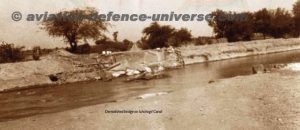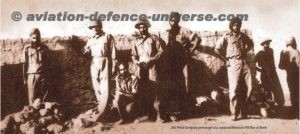Chinese Aggression 1962

The Chinese occupation of Tibet in 1950 should have come as no surprise to the Indian Government as the Chiang Kai Shek regime did not recognise the Mac-Mohan line as the boundary between China and India. India, keen to live in peace with its neighbour, coined the slogan ‘Hindi Chini Bhai Bhai’ to promote friendly feelings between the two countries, giving lowest priority to intrusions from Tibet.
Bickerings about the boundary commenced between the two countries, after the construction of a road by the Chinese through Aksai Chin in the Ladakh region, in Indian territory.
In 1960, the General Reserve Engineer Force (GREF) under the Border Roads Organisation was formed to develop roads along the 2,500 miles long border, in the most difficult terrain imaginable. 624 Corps Troops Engineers (commanded by Lt Col P L N Choudhary) with 18 and 19 Field Companies and 46 Field Park Company built a road to Tawang under ‘Project Tusker’. 632 Corps Troops Engineers and Project Beacon worked on the Srinagar-Zojila-Leh-Chushul road. In March 1961, 19 Field Company did considerable work on jungle clearance, road making, blasting and constructing retaining walls. A Class 5 road, about 20 miles long, was constructed from Dirang to Senge.
In accordance with the Indian Government’s ‘Forward Policy’, Dhola Post was established on the Namkachu river but the reaction of the Chinese was violent when a patrol of 50 men from 9 Punjab crossed the Namkachu and occupied Tsenge Dzong. Our men had to withdraw as the Chinese made it clear that they would not allow Indian troops to cross the Namkachu. Every effort was made to keep open the newly built road from the plains, despite heavy rains and accompanying landslides.
On 20 October 1962, the Chinese launched a massive attack on the Namkachu position overrunning the Indian Army posts. Positions at Tsangdhar and Nathung La were overrun a little later. As 7 Infantry Brigade had disintegrated, the protection of the road bridge at Jang assumed great importance for the rescue of Brig Kalyan Singh’s Brigade, as it was the only link to Tawang across the Tawang Chu.

18 Field Company was assigned this important duty with orders to blow up the bridge, if it was in danger of being captured by the Chinese. The Engineer firing party from 18 Field Company comprising 2Lt K C Dhingra, Nb Sub N Kadam and three Sappers destroyed the bridge in the face of two Chinese columns. 18 and 19 Field Companies built defences at Se La under 62 Infantry Brigade and carried out numerous tasks such as laying defensive minefields, construction of bunkers, underground storage dumps, advance dressing stations, approach roads and gun emplacements.
The Chinese made a wide encircling move over the unguarded Tse LaPoshing-La-Thembang route (to the east of Se La) to threaten Divisional Headquarters at Dirang Dzong. Impregnable Se La was abandoned without a fight. In the retreat that followed, many Officers and Other Ranks of 18 and 19 Field Companies were killed, and many were taken prisoner.
In the area of Lohit, Siang and Subansiri Divisions of NEFA, the main Chinese thrust developed along the Kibithoo- Walong axis. 368 Field Company just completing construction of 17 miles of mule track was forced to switch over to laying protective minefields at Walong.
Indo Pak War 1965
Emboldened by the major set-back against the Chinese in 1962, Pakistan, smarting from its inability to establish its regime in Kashmir, felt that the time was appropriate to renew its attempts in J&K to redeem its pledge to ‘free Kashmir from India’s clutches’. Exploiting India’s logistical imbalance of having to deploy troops both in the East and the West, it decided to launch a series of swift attacks in the Rann of Kutch, and succeeded in penetrating 7 miles into Indian territory, in an area where desert like conditions prevailed. The going over sand dunes and the lack of potable water created problems. It was at this point of time, that 411 Para Field Company under Maj S S Sawhney entered the fray as 50 Para Brigade was inducted into this sector to stem the advance under Op ‘Ablaze’. On induction, under HQ 9 Infantry Division, it laid extensive minefields. The Engineers, commanded by Lt Col A M Joglekar, with Maj M S Gosain, included four Field Companies: Maj B C Khanduri’s 21st, Maj M M Lal’s 96th and Maj Lalji’s 97th, and yet another Bombay Sapper unit, 46 Field Park Company under Maj S T Ranga Gowd. These units contributed tangibly to stabilizing the situation there.
Pakistani Operations in J&K The attempts of Pakistan under Op ‘Gibraltar’ to induct infiltrators into the Valley were thwarted effectively. Frustrated at this failure, on 1 September 1965, Pakistan launched Op ‘Grand Slam’ in the Chhamb Sector, in an attempt to capture the vital bridge over the Chenab at Akhnur, the lifeline to Naushera and Poonch. 191 Infantry Brigade, tasked with protecting this Sector, bore the brunt of Pakistan’s armoured attack that reached the Munnawartavi in Chhamb and Mandiala. Engineers of 10 Infantry Division under Lt Col Jagdev Singh supported the operations. Air strikes were invoked against enemy armoured columns attempting to drive a wedge between Mandiala and Chhamb in the battle for Jaurian. It was in the Akhnur Sector that 20 Field Company of the Bombay Sappers participated in the counter attacks by 28 Infantry Brigade, by ferrying supplies on improvised crafts across the water obstacle when the 300 feet long Balwinder Bridge was destroyed by enemy artillery fire. 30 Field Company under Maj Jagjit Singh entered the fray by reconstructing a timber bridge to enable mule trains to cross the obstacle.
11 Corps Operations To counter the thrust in Chhamb Sector, 11 and 1 Corps were launched in a counter offensive in the Punjab Sector. 11 Corps had Brig ‘Baba’ Bhide as its Chief Engineer. 474 Engineer Brigade headed by Col ‘Muddie’ Rao with three divisional engineer units was tasked to advance to the Ichchogil Canal and forestall any Pakistani counter offensive. At the same time, 50 Para Brigade with 411 Parachute Field Company under Maj Gurbir Man Singh reinforced the Ranian Sector, and was tasked to capture the Jallo Road Rail Bridge, discovered on arrival to have been demolished. The Company then laid extensive minefields in this area of operations. In the well documented Battle of Dograi, Sappers breached the enemy minefields, making it possible for 3 JAT and 13 PUNJAB to break through. 3 JAT was thus awarded the Battle Honour “Dograi”.
Participating in the 11 Corps central prong operations, 45 Field Park Company led by Maj S S Grewal, was involved in the 7 Division operations to capture Barki by creating a diversion, after the enemy had demolished the bridge over the Ichchogil Canal. To give the enemy the impression of an assault crossing over the Canal, the Company constructed a track from Burki to Karbath. The ploy worked, enabling 7 Division to capture Jhama But this was not the end of the Bombay Sappers involvement. 93 Field Company, led by Maj J K Malhotra, was actively involved in mine laying and breaching of the Upper Bari Doab Canal, thus allowing 7 and 4 Division’s flanks to be secure.
In the well crafted Battle of Assal Uttar in which 72 Pakistani Patton Tanks were destroyed, Engineer support, which was largely a Bengal Sapper affair, included Bombay Sappers of 363 Field Company under Maj R N Sehgal. This Company was deployed in improving defences including that of the Hudiara Drain, as an obstacle, mine laying in the Khemkaran Sector, repairs of culverts on the Rohinala-Bhikkiwind-Patti Road, and minefield breaching at Husseiniwala. 23, 380, and 484 Field Companies, with 301 Field Park Company under Lt Col K G Menon, were deployed in an infantry role in deliberate defence, for the protection of the road axis against infiltration.
Operations of 1 Corps 22 Field Company, under Maj B R Singh, was assigned a role in the thrust of 1 Corps across the Shakargarh salient, to provide engineer support to 69 and 99 Mountain Brigades in their advance towards Maharjke and Charwa. They were involved mainly in road construction and maintenance, and in lifting of anti-personnel/anti-tank mines, construction of an Auster airstrip and helipad, maintenance of water points, building of bunkers, and demolition of enemy bunkers. The Company was also associated in the widening to Class 9 specifications the vital Pindi-Charwa axis, and maintenance and mine laying at Phillora, contributing substantially to the holding by own troops at Maharajke, Charwa and Phillora after their capture.
The Relatively Quiet Eastern Sector Though the 1965 War was largely confined to the West, there was some engineering activity in the East that merits attention. Two Inland Water Transport (IWT) Units were inducted into the Eastern Sector HQ: 457 IWT Company under Lt Col J N Elisha, tasked with the role of operating 6 ferry sites over a distance of 300 miles on the Brahmaputra River from Jogigopa to Sadiya and 257 IWT Company moved from Calcutta to Chakdaba to be deployed under Op ‘Ablaze’. This IWT Unit also assisted HQ 457 IWT Company during Op ‘Riddle’. Maj N S Narahari’s 329 Field Park Company was given the task of manufacturing a number of expedients including the modification of Jeeps and 1 Ton Nissan Trucks as prime movers to haul wagons on metre and broad gauges respectively, common in this sector. They were also given the tasks of manufacturing improvised flexible track ways, long and short pickets for Sommerfeld trackways, and the design and fabrication of Class 9 fittings for wet gaps with variable pier heights.
Post Cease Fire Operations At the time of the Cease-Fire, India was in occupation of 140 square miles of Pakistan territory in the Lahore Sector, 180 square miles in the Sialkot Sector and 270 square miles in the Hajipir Bulge, Tithwal and Kargil Sectors of J&K. On the flip side, Pakistan was in occupation of Munabao in the Barmer Sector of Rajasthan, 20 square miles in Khemkaran and 190 square miles in the Chhamb-Jaurian Sector. In the Post Cease Fire period, 110 Engineer Regiment lifted mines and constructed some roads and tracks in the 16 Infantry Division Sector in the Punjab, and operated a Class 9 ferry over the River Chenab. 102 Engineer Regiment of the Group constructed demolition chambers in sensitive bridges near the border, and temporary bridges over new drains. 105 Engineer Regiment made track diversions and prefabricated shelters in the 25 Infantry Division Sector, South of the Pir Panjal.
The Bombay Sappers thus further enhanced their reputation in the 1965 Operations, and during the cease-fire period.























































































































